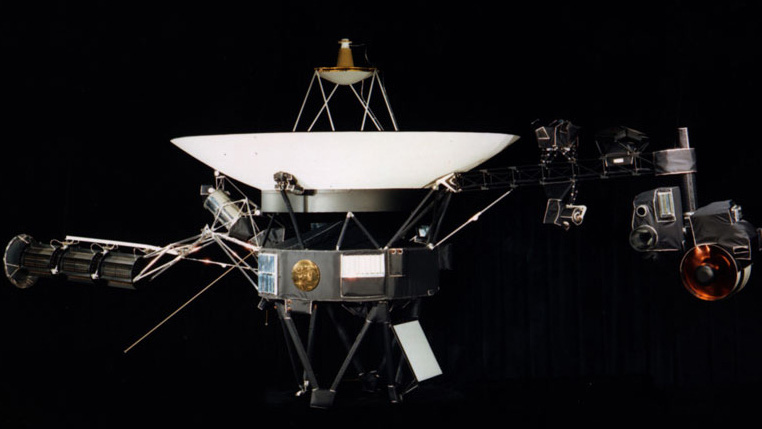NASA is confident it can recover the Voyager 1 but it'll require some time
Looks like our Voyager isn't lost in the stars, after all

The historic NASA Voyager 1 probe, the farthest man-made object from Earth, has been malfunctioning in deep space due to a critical memory error since November 14th, 2023. However, the issue has now been diagnosed and seems fixable!
Back in March, we reported that NASA was sending a "poke" to the Flight Data Subsystem to get a full readout of the probe's functioning memory in hopes of fixing it. The poke worked but returned a scrambled readout that NASA had to decode before it could be of any value.
Here in April, it seems like that readout has finally borne fruit and identified the issue. According to NASA and a report from Ars Technica, "It may take weeks or months. Engineers are optimistic they can find a way for the FDS to operate normally without the unusable memory hardware, which would enable Voyager 1 to begin returning science and engineering data."
In a new blog post, NASA disclosed that they suspect a single chip comprising roughly 3% of the FDS' volatile memory was causing the problem. The "fix" to the issue seems to be finding a way to operate the FDS without relying on the corrupted memory, though the exact process remains uncertain. As of the time of writing, NASA's Deep Space Network Now page still doesn't know an incoming signal from Voyager 1— but we can expect to see it again in the coming months.
Overall, this optimistic turn in the saga of the lost Voyager probe is nice. It would have been perfectly understandable at 45 years old and a 1977 launch if it were simply unfixable after all this time. Instead, the ingenuity of the original engineers who launched the spacecraft still lives on and has caused a fatal memory error in deep space, an issue that seems fixable. Considering how frequently regular old RAM and storage fail in our modern era, seeing a direct ancestor still hold up so well after all this time is impressive.
For now, Voyager 1's galactic odyssey will continue for years as soon as NASA finishes fixing its FDS error—or helping Voyager 1 "catch its breath," so to speak. Who wouldn't need a break after 45 years?
Get Tom's Hardware's best news and in-depth reviews, straight to your inbox.

Christopher Harper has been a successful freelance tech writer specializing in PC hardware and gaming since 2015, and ghostwrote for various B2B clients in High School before that. Outside of work, Christopher is best known to friends and rivals as an active competitive player in various eSports (particularly fighting games and arena shooters) and a purveyor of music ranging from Jimi Hendrix to Killer Mike to the Sonic Adventure 2 soundtrack.
-
vanadiel007 Recover typically means to go get it. Strange title for an Article. Should likely be something about the lines of "it can get Voyager 1 to recover"Reply -
umeng2002_2 I just want aliens to capture it and return it with a smoking hot bald model like in Star Trek 1.Reply -
icraft ReplyInstead, the ingenuity of the original engineers who launched the spacecraft still lives on and has caused a fatal memory error in deep space
Uh, what -
Alvar "Miles" Udell Hardware built in the 70s by the lowest bidder exposed to high energy radiation, micro-meteroids, and temperatures less than 3°K: Fails after 45 years.Reply
Hardware built in the 90s by the lowest bidder in Earth's orbit shielded by its magnetic field (Hubble): Multiple repair missions and component replacements required to maintain functionality.
Hardware built in the 2020s on Earth shielded from radiation and kept in temperature and hazard controlled environments: Fails before warranty expires (or even before it's paid off).
At this rate in another decade things will fail before they even leave the factory. -
USAFRet Reply
See the current game software ecosystem.Alvar Miles Udell said:At this rate in another decade things will fail before they even leave the factory. -
Alvar "Miles" Udell ReplyUSAFRet said:See the current game software ecosystem.
Not just games, Microsoft, Google's, and Apple's operating system patches cause chaos most of the time. -
6502 It's "peek" instead of "poke". Or perhaps more precisely "dump" to emphasis on the scale of it.Reply
By several decades of conventions, "peek" (and "dump") reads from the memory while "poke" writes into memory.
In this situation, hopefully perhaps the latter will fix the problem when the time comes to decide on the action. -
Priscus Reply
Now that does take me back.6502 said:It's "peek" instead of "poke". Or perhaps more precisely "dump" to emphasis on the scale of it.
By several decades of conventions, "peek" (and "dump") reads from the memory while "poke" writes into memory.
In this situation, hopefully perhaps the latter will fix the problem when the time comes to decide on the action.
Remember when getting your hands on an eight bit microprocessor, meant some circuit construction to get it to do anything. Then you hand assembled the machine code, using switches and LEDs to set each bit at a time: there was NO software available.
It was laborious, so next development was a little machine code routine to read entry from a hex keypad, and place in the memory locations specified in a register that you also primed from the hex keypad. Next, a routine and some circuitry to display this content on seven segment displays.
These two routines became your 'PEEK' and 'POKE' code that could be called once you progressed to an alphanumeric keyboard: prior to that, you had activated a switch to perform the action, so had not needed to name them.
They were the first routines you needed to write, apart from initialising the processor and driving the keyboard and seven segment displays.